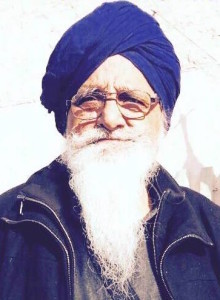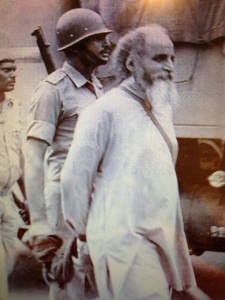by
SAFAR
July 21, 2015

Photo Above: Surat Singh and his wife, the late Mrs. Satpal Kaur.
Punjab’s recent “Hunger Games” have reached a dangerous and decisive point after enhanced police crackdown on Bapu Surat Singh on July 20, 2015. Do we have all the facts?
In a quest to unravel the selective newspaper headlines and to understand more of the back story, the Sikh Feminist Research Institute (SAFAR) has interviewed the friends and family of Bapu Surat Singh about the man and the mission, and the many women, especially his daughters, who have been supporting his principled stance and sacrifice.
1. SURAT SINGH WAS A GOVERNMENT SCHOOLTEACHER UNTIL 1984
In June 1984, after the Indian army’s attack on Punjab, Surat Singh was shaken as part of the targeted Sikh community, and resigned his government job in protest. In the following years, he was part of a Sikh political group, publically and openly raising human rights issues–nothing underground, nothing secret. He was jailed for his political activism several times. He has no criminal record.
2. “DADDY”: LONG BEFORE HE BECAME BAPU SURAT SINGH KHALSA IN THE NEWS
 Surat
Singh is “Daddy” to six loving children, five daughters and one
son. He was born in Hasanpur, Ludhiana, 83 years ago. Given the
situation in Punjab, in 1988 Surat Singh and his wife Satpal Kaur,
along with their children, joined the thousands of Sikh emigrants to
the United States. While his children established themselves in their
new home, Surat Singh continued traveling back to his beloved Punjab
as often as he could. In January of this year, he returned to
Hasanpur, Punjab.
Surat
Singh is “Daddy” to six loving children, five daughters and one
son. He was born in Hasanpur, Ludhiana, 83 years ago. Given the
situation in Punjab, in 1988 Surat Singh and his wife Satpal Kaur,
along with their children, joined the thousands of Sikh emigrants to
the United States. While his children established themselves in their
new home, Surat Singh continued traveling back to his beloved Punjab
as often as he could. In January of this year, he returned to
Hasanpur, Punjab.
Photo Left: Surat Singh with his granddaughter Harjas Kaur, his son’s daughter. Harjus’ father Ravinderjit Singh was in Punjab, where he was illegally and arbitrarily detained and jailed, without court hearing, between February 26 to April 27, 2015, for visiting with Surat Singh
3. 83-YEAR-OLD SURAT SINGH HAS BEEN ON HUNGER STRIKE SINCE JANUARY 16, 2015
When he left California, his family did not know of his intention to begin a hunger strike unto death. However, his decision did not surprise them; he always invoked the lessons of Guru Nanak: that the concept of family extends beyond that of biological family.
Surat Singh had followed the news about Mr. Gurbaksh Singh, who executed his first hunger strike in 2013 and then another in 2014. Gurbaksh Singh recited an ardaas (a solemn Sikh supplication), proclaiming that he would protest, by fasting, the unjust imprisonment of political activists by the Indian government until they were freed. When he was not able to compel the release of the prisoners and gave up his fast, Surat Singh took the mantle. Surat Singh believes in staying committed to those behind bars since the 1980s, and to their families waiting indefinitely.
4. SURAT SINGH HAS NEVER TAKEN UP ARMS. HE WAGES A NON-VIOLENT BATTLE: FASTING IS HIS STRATEGY, NOT SUICIDE.
 In the
1980s, when some Sikhs in Punjab took up arms, they were not only
personally thwarted, but also entire countrysides were ravaged,
leaving incomplete families with interrupted dreams in their wake.
Most of these families have continued to be turned away by
the legal system, the media, and the government, cast aside as
“extremists.” Surat Singh never took up arms. Instead, he pursued
a non-violent route. Yet, during a peaceful protest rally in February
1986, he was shot in the leg by Punjab Police. Also, for his
political activism, he was detained several times. He realized that
the best way for the political apparatus to undermine him would be to
accuse him of being violent. With the Sikh spirit of creativity and
resistance with grace, Surat Singh decided to protest, in overt
peacefulness, with his body through a hunger-strike, a manner
historically celebrated in South Asia. His mission is not suicide,
but rather, is about civil disobedience, resistance, and seeking
justice without violence.
In the
1980s, when some Sikhs in Punjab took up arms, they were not only
personally thwarted, but also entire countrysides were ravaged,
leaving incomplete families with interrupted dreams in their wake.
Most of these families have continued to be turned away by
the legal system, the media, and the government, cast aside as
“extremists.” Surat Singh never took up arms. Instead, he pursued
a non-violent route. Yet, during a peaceful protest rally in February
1986, he was shot in the leg by Punjab Police. Also, for his
political activism, he was detained several times. He realized that
the best way for the political apparatus to undermine him would be to
accuse him of being violent. With the Sikh spirit of creativity and
resistance with grace, Surat Singh decided to protest, in overt
peacefulness, with his body through a hunger-strike, a manner
historically celebrated in South Asia. His mission is not suicide,
but rather, is about civil disobedience, resistance, and seeking
justice without violence.
History sets precedent of protests against stark odds that were not considered suicidal but rather, revolutionary: be it on the roads of Selma, the Ghadarites traveling back to colonial guns, the battle of Chamkaur, Spartans battling Thermopylae, or Mandela protesting apartheid. History was and continues to be on the side of Surat Singh.
5. SURAT SINGH HAS BEEN AN ICONIC ACTIVIST FOR DECADES.
During a 1985 protest in Amritsar, Surat Singh and other Sikhs were illegally detained. Adding insult to injury, the paramilitary stripped away this proud Sikh’s turban in public.
6. SURAT SINGH IS DEMANDING JUSTICE FOR POLITICAL PRISONERS.
 Punjab
saw over a decade of conflict. There are men in jail
for conflict-related violence, alleged crimes, and non-violent
crimes; some are now in their late 70s and 80s. Many were convicted
under the now repealed Terrorist and Disruptive Activities
(Prevention) Act (TADA), which national and international groups have
widely condemned as “draconian.” Surat Singh is asking
for the release of these men, particularly for those who have no
pending case in any legal court, have shown good behavior in prisons,
and are senior citizens. Regardless of the debate around the
unjustness of their underlying sentence or the context of
conflict, it is important to note that those on his list have served
the terms of the sentences given to them by conflict-era courts.
Surat Singh considers such asks as “common sense.” Yet,
main-stream media and the Indian government paint his cause as
“radical” and “hardline.”
Punjab
saw over a decade of conflict. There are men in jail
for conflict-related violence, alleged crimes, and non-violent
crimes; some are now in their late 70s and 80s. Many were convicted
under the now repealed Terrorist and Disruptive Activities
(Prevention) Act (TADA), which national and international groups have
widely condemned as “draconian.” Surat Singh is asking
for the release of these men, particularly for those who have no
pending case in any legal court, have shown good behavior in prisons,
and are senior citizens. Regardless of the debate around the
unjustness of their underlying sentence or the context of
conflict, it is important to note that those on his list have served
the terms of the sentences given to them by conflict-era courts.
Surat Singh considers such asks as “common sense.” Yet,
main-stream media and the Indian government paint his cause as
“radical” and “hardline.”
Photo Left: This iconic photograph from the 1980s, seen in many human rights reports, is none other than Bapu Surat Singh. This photo is a reminder of very recent historical context that Surat Singh’s protest is challenging people to not forget.
7. IN RESPONSE TO SURAT SINGH’S PEACEFUL PROTEST, HE AND HIS FAMILY HAVE SUFFERED VIOLENCE, INTIMIDATION, PHYSICAL AND LEGAL HARASSMENT.
The Indian Government’s reaction escalated from ignoring, belittling, slander, to violence, arrest and force-feedingof Surat Singh. When Ravinderjit Singh (Surat Singh’s son) travelled from the U.S. to see his father in his declining health, he was illegally and arbitrarily detained and jailed, without court hearing and, between February 26 to April 27, 2015, put in solitary detention, and beaten by a police official in front of a courthouse. As pressure from groups like People’s Union for Civil Liberties (PUCL), the people of Punjab, and lawyers of Punjab mounted, the government suddenly released Ravinderjit Singh. A few days earlier, on April 23, in the middle of the night, without notice, the police released Surat Singh from force feeding, placed him in a wheelchair and told him he was free to go. Since this incident, Surat Singh has been in his village of Hasanpur, Punjab where a diverse group of Sikhs visit, support him, and vigil over him, in an attempt to prevent another arrest. All that changed again on July 20, 2015.
8. WHILE THE MEDIA IS MOSTLY CARRYING PHOTOGRAPHS OF ANGRY SIKH MEN AND STORIES OF VIOLENCE, PUNJAB IS IN FACT SEEING PEACEFUL CIVIL DISOBEDIENCE SUPPORTED BY WOMEN AND MEN.
 For
the past few weeks days, while hundreds of supporters were flocking
trying to visit Surat Singh, the police and paramilitary cordon
around his village had reportedly been intensifying. Then water and
electricity to Surat Singh’s home was mysteriously cut. Finally, on
July 20, while senior officials were inside the house with Surat
Singh, his son, daughter, and a few supporters, convincing Surat
Singh to break his fast, chaos broke out outside the house. Led by
junior level police officials and vigilante militia groups, the
village was raided and supporters were threatened and beaten. Two bus
full of people were detained and driven away by the police. Videos
from inside the house show the few people left asking the Deputy
Commission (the highest ranking government official of the area) how
this could happened on his watch. He claimed ignorance,
miscommunication, and government incoordination. Meanwhile, Surat
Singh’s property was destroyed during the police action on his
home including vandalism, broken dishes, and cut electrical
wires cut.
For
the past few weeks days, while hundreds of supporters were flocking
trying to visit Surat Singh, the police and paramilitary cordon
around his village had reportedly been intensifying. Then water and
electricity to Surat Singh’s home was mysteriously cut. Finally, on
July 20, while senior officials were inside the house with Surat
Singh, his son, daughter, and a few supporters, convincing Surat
Singh to break his fast, chaos broke out outside the house. Led by
junior level police officials and vigilante militia groups, the
village was raided and supporters were threatened and beaten. Two bus
full of people were detained and driven away by the police. Videos
from inside the house show the few people left asking the Deputy
Commission (the highest ranking government official of the area) how
this could happened on his watch. He claimed ignorance,
miscommunication, and government incoordination. Meanwhile, Surat
Singh’s property was destroyed during the police action on his
home including vandalism, broken dishes, and cut electrical
wires cut.
9. SURAT SINGH’S DAUGHTERS DO NOT BELIEVE SITTING ON THE SIDELINES IS CONSONANT WITH SIKH ETHOS.
Surat Singh’s eldest child, Sarvinder Kaur, has been the family spokesperson since Surat Singh started his protest. Away from her own children and family for over six months, she has been steadfast. In a recent video, as non-uniformed people and policemen are seen removing a camera and other property from the family verandah, Sarvinder Kaur is heard asking again, “Are you the police or some petty thief?” In the midst of her father’s declining health and the mounting pressure, she remains composed and courageous and clearly articulates the injustices she witnesses. She and her siblings draw strength from each other and refuse to be fractured by detractors and the police. They believes they are supporting a cause bigger than Surat Singh, one of truth and justice. “I look at my daughter and know, however things turn out, one day she will be interviewing me about this period, asking me what I have done,” says another daughter of Surat Singh.
10. SURAT SINGH EXPECTS PEOPLE TO CONTINUE HIS PRINCIPLED STRUGGLE, BEYOND HIS DEATHBED.
 As of
July 20, 2015 Surat Singh has refused water, and his lips are dried
shut. In his last recorded statements he again tries to
re-focus everyone’s attention to the underlying issue: the rights
of political prisoners. His family believes it is not time to lose
heart, but to think positivity and creatively.
As of
July 20, 2015 Surat Singh has refused water, and his lips are dried
shut. In his last recorded statements he again tries to
re-focus everyone’s attention to the underlying issue: the rights
of political prisoners. His family believes it is not time to lose
heart, but to think positivity and creatively.
This cause is not about those prisoners’ politics but rather, is about their rights. It is also about the rights of men and women arrested on July 20, 2015; and it is about Surat Singh, a father who has inspired many. His call is to come together and act. For him, nothing is too small, but doing nothing at all is not an option. Calling upon governments and media for fair attention to the issue is a first step many can take.
As Sikh feminists, we deeply respect that this father inspires by peaceful example, rather than by simple talk.
Above Photo: Sarvinder Kaur with her niece and nephew ‒ Ravinderjit’s Singh children ‒ at their village house in Hussanpura. Source: Scroll.in
-------------------------------------------------------
SAFAR, the Sikh Feminist Research Institute, envisions a world where the Sikh Gurus’ principles of egalitarianism and empowerment are realized for all, regardless of ability, caste, class, ethnicity, gender, race, sex, and sexual orientation, by bringing expansive revival, attention, voice and praxis to the feminist values and egalitarian politics inherent within Sikhi.

